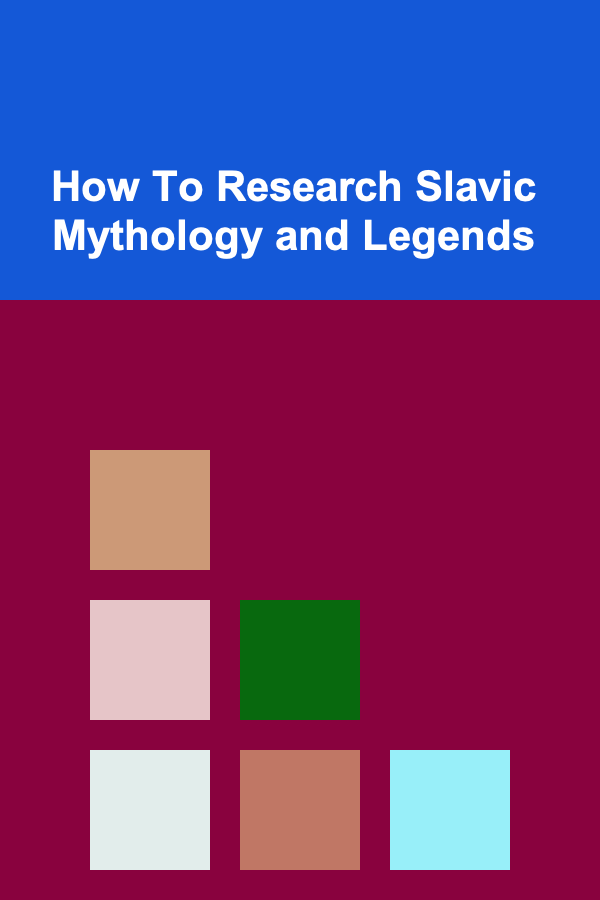
How To Research Slavic Mythology and Legends
ebook include PDF & Audio bundle (Micro Guide)
$12.99$10.99
Limited Time Offer! Order within the next:

Slavic mythology, a rich and diverse collection of ancient beliefs and legends from the Slavic peoples of Eastern Europe, holds a special place in world mythologies. This tradition is steeped in spirituality, folklore, and a deep connection with nature, reflecting the unique cultural heritage of the Slavic nations. If you're interested in exploring Slavic mythology, this guide will walk you through the essential steps for researching and understanding these fascinating myths and legends.
1. Understanding the Context of Slavic Mythology
Before diving into the specifics of Slavic mythology, it's crucial to grasp the historical and cultural context in which these beliefs evolved. The Slavic people are divided into three main subgroups: East Slavs, West Slavs, and South Slavs. These groups are geographically distributed across Russia, Ukraine, Poland, the Czech Republic, Slovakia, the Balkans, and more.
Slavic mythology is deeply intertwined with the natural world, focusing on the forces of nature, the spiritual world, and the cyclical nature of life and death. It has roots in pre-Christian religious practices and was orally transmitted through generations. Key themes in Slavic mythology include the worship of nature gods, spirits of the land and water, ancestral spirits, and mythical creatures.
Slavic mythology is not a monolithic tradition but consists of various regional and national variations. Thus, it's important to consider the specific cultural background of the region you're studying.
2. Familiarizing Yourself with Primary Sources
Researching Slavic mythology begins with examining primary sources --- texts, historical accounts, and folklore collections that preserve the stories and beliefs of the Slavic peoples.
2.1 Folklore and Legends
A significant portion of Slavic mythology has been passed down through oral traditions. Folklore consists of stories, songs, and rituals that reflect the daily lives, fears, hopes, and beliefs of the people. These tales often feature gods, goddesses, spirits, and mythical creatures, as well as stories of the afterlife.
Key works include:
- "The Russian Primary Chronicle" (also known as the "Tale of Bygone Years"): A foundational historical text for the East Slavic world that provides insight into early Slavic mythology.
- "The Song of Igor's Campaign": A 12th-century epic poem that blends historical events with mythological elements, providing a glimpse into the worldview of the Kievan Rus.
- Folklore Collections: Numerous regional folklore collections have been compiled by scholars like Aleksandr Afanasyev, who collected Russian folktales in the 19th century. These collections include stories about magical creatures like domovoi (household spirits), rusalka (water nymphs), and baba yaga (the witch).
While much of Slavic mythology is embedded in oral tradition, numerous 19th and 20th-century scholars and folklorists began collecting these stories into written forms. These texts remain critical resources for anyone researching Slavic mythology.
2.2 Historical Accounts
In addition to folklore, historical accounts written by early Christian monks or travelers offer important perspectives on Slavic mythology. Many early Christian missionaries attempted to convert Slavic peoples, and their writings often contain descriptions of pagan rituals, gods, and spiritual practices.
However, be cautious, as these writings were often biased, portraying pagan beliefs as backward or even diabolical. Still, these accounts provide valuable insight into how Slavic societies practiced their spirituality before the rise of Christianity.
Examples include:
- The work of chroniclers like Nestor, who documented early Slavic beliefs and practices in Eastern Europe.
- Christian missionary texts from the medieval period that describe the conflict between paganism and Christianity.
2.3 Archaeological Discoveries
Archaeological findings can also offer valuable insights into Slavic beliefs. Excavations of ancient Slavic settlements, burial mounds, and religious sites have revealed artifacts that provide evidence of the Slavic people's spiritual practices. Sacred objects, idols, and shrines dedicated to pagan deities can shed light on their religious customs.
While archaeological findings might not offer direct stories or narratives, they help contextualize the cultural and spiritual significance of various elements in Slavic mythology.
3. Key Themes and Figures in Slavic Mythology
A major component of researching Slavic mythology is understanding the central figures and themes that appear across various legends. Here are some of the most important aspects of Slavic mythology:
3.1 The Pantheon of Gods
Slavic mythology is populated by a wide array of gods and goddesses, each responsible for different aspects of the natural world and human existence. The deities vary across regions, but some central figures include:
- Perun: The god of thunder and war, often depicted as a powerful figure wielding a hammer or axe.
- Veles: A god of cattle, commerce, and the underworld, frequently depicted as a serpent or dragon.
- Dazhbog: The sun god, often associated with wealth, light, and fertility.
- Mokosh: The earth goddess, often considered the protector of women, fertility, and harvests.
- Rod: The god of family and ancestry, sometimes seen as the father of all gods.
Each god and goddess had specific attributes and responsibilities, and their worship often included sacrifices, rituals, and festivals to ensure balance in the natural and spiritual worlds.
3.2 Spirits and Mythical Creatures
Beyond the gods, Slavic mythology features a diverse array of spirits and mythical creatures that embody various aspects of nature and human existence. Some of the most iconic beings include:
- Baba Yaga: Perhaps the most famous figure in Slavic mythology, Baba Yaga is a witch-like figure who lives in a hut on chicken legs. She is often portrayed as a villain, but she also has a role as a guardian of wisdom and protector of certain boundaries.
- Domovoi: The spirit of the household, responsible for protecting the home and family. A household's well-being was often attributed to the presence and behavior of the domovoi.
- Rusalka: Water spirits or nymphs, usually associated with lakes, rivers, and other bodies of water. Rusalki are often depicted as beautiful women who can either be benevolent or malevolent, depending on the legend.
- Koschei the Deathless: A powerful, evil figure who cannot die due to his soul being hidden away. Koschei is often a primary antagonist in Slavic folklore, particularly in fairy tales.
Understanding these creatures' roles in Slavic mythology allows researchers to appreciate the deep connection between the Slavic people and their environment, as well as their views on the supernatural.
3.3 Life, Death, and the Afterlife
In Slavic mythology, life and death are viewed as a continuous cycle. Ancestor worship was common, and the afterlife was often depicted as a realm governed by deities like Veles, the god of the underworld. Spirits of the deceased were believed to live on, with rituals designed to appease these spirits and ensure they didn't cause harm.
Rituals and celebrations around death and the afterlife played an essential role in daily life. The dead were honored through offerings and prayers, and their spirits were believed to be active participants in the lives of the living.
4. Secondary Sources for Slavic Mythology
While primary sources provide the foundation for studying Slavic mythology, secondary sources help contextualize and analyze these myths in a broader cultural and historical framework. Scholars and researchers have written extensively on Slavic mythology, often analyzing its role in shaping Slavic identities and how it reflects societal values.
4.1 Books and Scholarly Articles
Many historians, anthropologists, and folklorists have written in-depth studies on Slavic mythology, offering interpretations and analyses of various myths, figures, and rituals. Some key authors in this field include:
- Vladimir Propp: A Russian folklorist whose work on the morphology of fairy tales provides a valuable theoretical framework for understanding Slavic folklore.
- Jana Housová: A contemporary scholar of Slavic mythology who has written extensively on the mythology and religious practices of Eastern Europe.
- Miroslav S. Hroch: A historian who has analyzed the role of mythology in shaping the national identities of Slavic peoples.
Reading these works will give you a broader understanding of the cultural, social, and historical significance of Slavic myths.
4.2 Documentaries and Multimedia Resources
In addition to books and scholarly articles, documentaries and multimedia resources can be an excellent way to deepen your understanding of Slavic mythology. These resources often include interviews with experts, visual depictions of folklore, and insights into how these myths continue to influence Slavic cultures today.
5. Engaging with Modern Interpretations of Slavic Mythology
As Slavic mythology continues to evolve, it plays a significant role in contemporary culture. Writers, artists, and filmmakers have drawn inspiration from ancient myths, reimagining them for modern audiences. Understanding how modern creators engage with Slavic mythology can offer insight into its continued relevance and adaptability.
5.1 Literature and Fiction
Many authors, both Slavic and non-Slavic, have incorporated Slavic myths into their works of fiction. The works of authors like Aleksandr Pushkin , Mikhail Bulgakov , and Neil Gaiman (in his book American Gods) provide modern interpretations of Slavic myths and characters.
5.2 Cinema and Art
Modern cinema, especially in Russia and Eastern Europe, often draws upon Slavic folklore to create atmospheric films that explore themes of magic, horror, and the supernatural. Directors like Andrei Tarkovsky and Aleksandr Sokurov have created films that incorporate Slavic mythological themes and motifs.
6. Conclusion
Researching Slavic mythology and legends requires a multi-faceted approach that incorporates primary sources, historical context, and modern interpretations. Understanding the gods, spirits, and creatures that populate Slavic folklore is only part of the story. By exploring how these myths have influenced and been shaped by the Slavic peoples, you can gain a deeper appreciation for the intricate tapestry of beliefs that have persisted for centuries.
With a combination of academic resources, cultural analysis, and creative interpretations, the world of Slavic mythology becomes a fascinating and dynamic field to explore. Whether you're a scholar, a writer, or just a curious reader, the myths of the Slavic people offer endless opportunities for discovery and insight.

How to Create a Checklist for Construction Site Safety Inspections
Read More
How to Organize Essential Oils by Use and Purpose
Read More
How to Properly Care for Your Vacuum Cleaner
Read More
Choosing the Right Lip Balm for Hydration
Read More
10 Tips for Finding High-Paying SEO Specialist Jobs
Read More
10 Tips for Creating DIY Photo Props on a Budget
Read MoreOther Products

How to Create a Checklist for Construction Site Safety Inspections
Read More
How to Organize Essential Oils by Use and Purpose
Read More
How to Properly Care for Your Vacuum Cleaner
Read More
Choosing the Right Lip Balm for Hydration
Read More
10 Tips for Finding High-Paying SEO Specialist Jobs
Read More